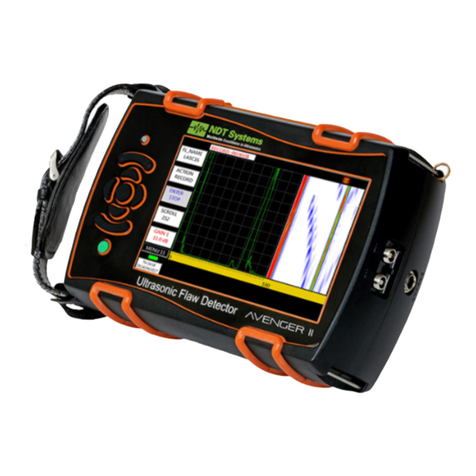
Bondascope 350 Operator's Manual
1 INTRODUCTION ..................................................................................................................................... 1
1.1 IMPORTANT: ................................................................................................................................... 1
1.2 General Features: ............................................................................................................................... 1
2 AREAS OF APPLICATION ..................................................................................................................... 2
3 PRINCIPLE OF OPERATION.................................................................................................................. 3
3.1 Resonance: ......................................................................................................................................... 3
3.2 Pitch-Catch:........................................................................................................................................ 3
4 4.0 BASIC DESIGN .................................................................................................................................. 4
5 Description of Connections........................................................................................................................ 5
6 PREPARATION FOR USE....................................................................................................................... 6
6.1 Batteries: ............................................................................................................................................ 6
6.2 Probe Selection : ................................................................................................................................ 7
6.3 Reference Samples - IMPORTANT!!................................................................................................ 7
7 KEYPAD AND OPERATION.................................................................................................................. 8
7.1 ON/OFF COMMAND....................................................................................................................... 8
7.2 SETUP ............................................................................................................................................... 8
7.3 GAIN.................................................................................................................................................. 8
7.4 MENU/ESC BUTTON ...................................................................................................................... 8
7.5 LEFT, RIGHT, UP, DOWN ARROW and ENTER Keys................................................................. 8
7.6 NULL – Also acts as a BALANCING function where required ....................................................... 8
7.7 PROFILE ........................................................................................................................................... 9
7.8 Alarm Key.......................................................................................................................................... 9
7.9 MODE Keys (RF/DOTS, SWEEP & GATES) ................................................................................. 9
7.9.1 RF / DOTS Key.............................................................................................................................. 9
7.9.2 SWEEP Key................................................................................................................................... 9
7.9.3 GATES Key................................................................................................................................... 9
8 MAIN SCREEN & MENU Items............................................................................................................ 11
8.1 Main Menu Screen........................................................................................................................... 11
8.2 MAIN MENU ITEM DESCRIPTION ............................................................................................ 12
8.2.1 Gain.............................................................................................................................................. 12
8.2.2 RNG – RANGE ........................................................................................................................... 12
8.2.3 DLY – DELAY............................................................................................................................ 12
8.2.4 VLTS - VOLTS ........................................................................................................................... 12
8.2.5 GATE........................................................................................................................................... 12
8.2.6 FREQ – FREQUENCY ............................................................................................................... 12
8.2.7 PRB – PROBE ............................................................................................................................. 12
8.2.8 CYCLES ...................................................................................................................................... 12
8.2.9 DISP............................................................................................................................................. 13
8.2.10 ALRM – ALARM........................................................................................................................ 13
8.2.11 SET - SETUP............................................................................................................................... 14
8.2.12 SCRN - SCREEN SAVE............................................................................................................. 14
8.3 MAIN MENU ITEM OPERATION................................................................................................ 15
8.3.1 DOTS ........................................................................................................................................... 15
8.3.2 FREQ - FREQUENCY................................................................................................................ 15
8.3.3 ROT – ROTATE.......................................................................................................................... 15
8.3.4 POS - Position.............................................................................................................................. 16
8.3.5 Xscl – X Scale Factor................................................................................................................... 16
8.3.6 Yscl – Y Scale Factor................................................................................................................... 16




























